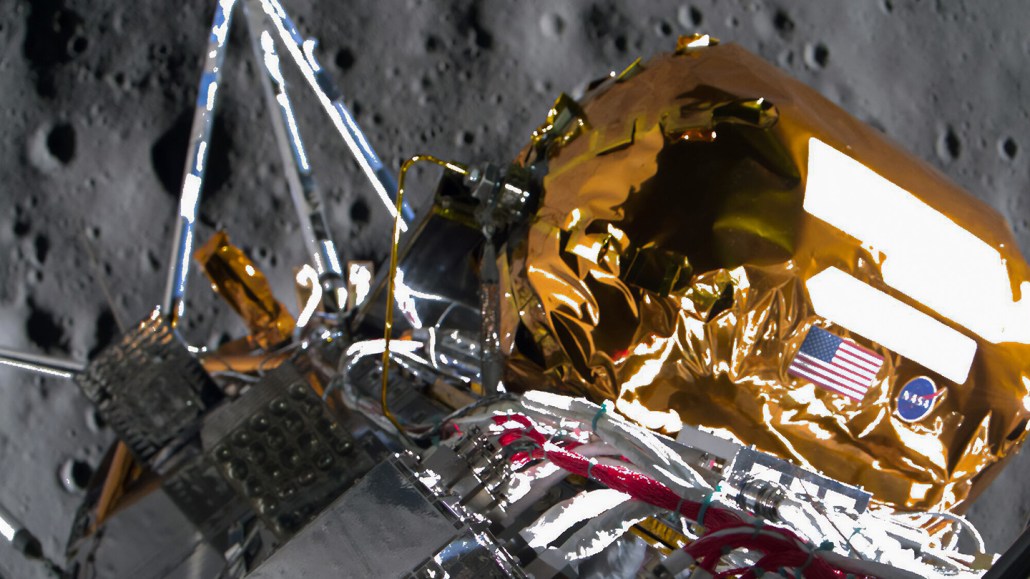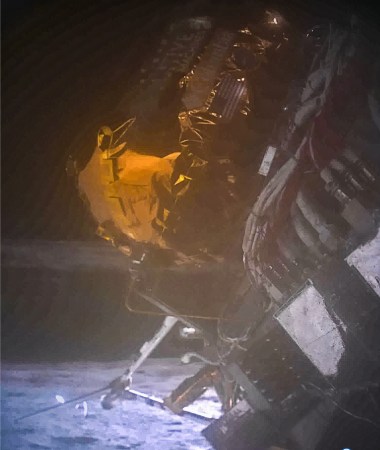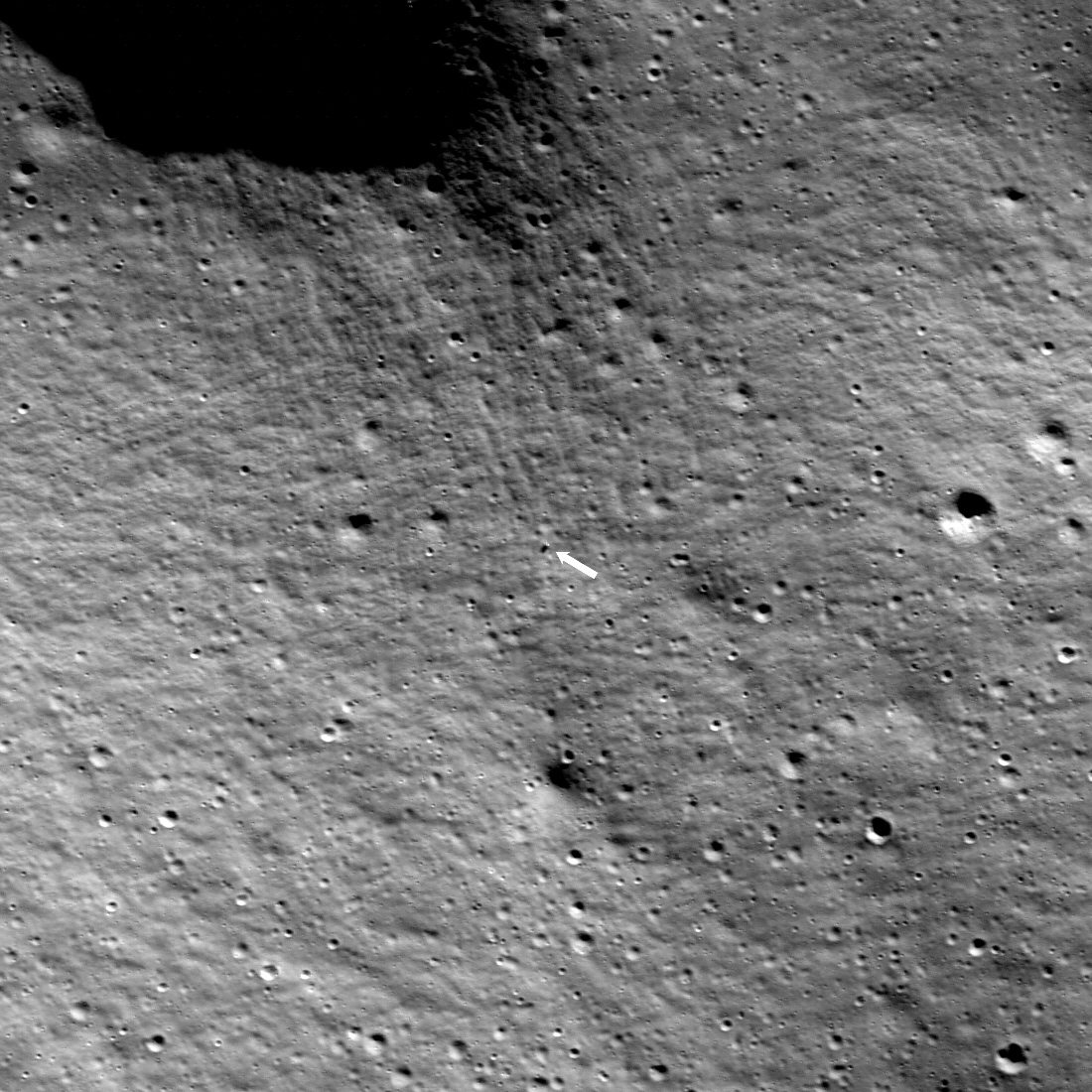Odysseus’ historic moon mission comes to an end
The spindly lunar lander lost power and shut down February 28, and could not be reawakened

Intuitive Machines’ Odysseus lander snapped this photo when it was approximately 30 meters above the lunar surface and descending at a screaming 38,000 kilometers per hour before touching down February 22.
Official Intuitive Machines Photos (CC BY-NC-ND 2.0 DEED)
Odysseus has exceeded engineers’ expectations during its odyssey on the moon. NASA confirmed that the spindly solar-powered robotic lander, built and operated by the Houston-based private U.S. company Intuitive Machines, was alive and collecting data after it touched down, and toppled over, on the lunar surface on February 22.
“What a magnificent job that lander did,” said Intuitive Machines CEO Steve Altemus during a NASA news briefing on February 28. “So much data and information and science. It’s just an incredible testament to how robust that little spacecraft is, so we’re really happy with that.”

The spacecraft, which carried payloads from universities, industry and NASA, was the first American spacecraft to perform a soft landing on the moon in more than 50 years (SN: 2/22/24). As Odysseus, or Odie as it’s nicknamed, was slowly running out of power, scientists put it into sleep mode February 28, after roughly six days on the lunar surface. Engineers tried multiple times to reawaken the spacecraft a few weeks later but, on March 23, flight controllers concluded that its batteries had been too degraded by the cold lunar night and that the mission had come to a close.
“Odie has permanently faded after cementing its legacy into history as the first commercial lunar lander to land on the moon,” the company posted on X (formerly Twitter).
Much like its namesake, the epic hero from the Greek classic The Odyssey, the spacecraft Odysseus underwent trials and tribulations in its journey. Its autonomous landing system’s laser range finder malfunctioned, causing engineers to scramble for a solution that involved two extra hours in orbit and reconfiguring a couple backup lasers on a NASA payload. After a nail-biting descent, Odysseus’s landing gear caught on the sloped ground or possibly a crevice, breaking the gear and sending the spacecraft gently tipping over on its side.
Despite the mishap, “our navigation system landed us with precision and the shock absorbers took the load,” Altemus said. “The landing gear did what it was supposed to do and protect the lander as it landed on the surface.”
The spacecraft was originally supposed to operate for about a week, though during a Feb. 23 briefing with reporters mission director Tim Crain, chief technology officer of Intuitive Machines, said that under the best case scenario it might last for nine to 10 days.
Instead, after six days on the moon, the lander was expected to run out of power. “We’re going to tuck Odie in for the cold night of the moon,” Crain said during the Feb. 28 briefing. “We are going to leave the computers and the power system in a place where we can wake it up … once it gets power again.”
The main limiting factor to whether Odysseus would come back online was its batteries; their chemistry-based technology would struggle with the extreme temperature plunge of lunar night. “We’re confident that when the sun comes back up, the solar arrays will energize and they’ll send power,” Crain said at the time. “The real question is, ‘Are the batteries there to receive that power and pass it on?’” Apparently, they weren’t.
Odysseus, which stands about 4 meters tall and 1.5 meters wide, came down at a site roughly 300 kilometers away from the lunar south pole on the slope of a crater called Malapert A. Astronauts with NASA’s crewed Artemis program may land at a similar site or nearby in the coming decades (SN: 12/1/22).
Some of the spacecraft’s various payloads have had their own little adventures during the mission. For instance, a camera built by students at Embry-Riddle Aeronautical University in Daytona Beach, Fla., was supposed to detach during descent and take pictures as the spacecraft touched down. Due to the problems with landing, the camera, known as EagleCam, was not deployed, but Crain said he and others are working on getting it ready for ejection.

But the International Lunar Observatory Association, a private company based in Kamuela, Hawaii, has received images from a telescope it sent on Odysseus named ILO‐X. The instrument is a precursor to a larger telescope the company hopes to deploy at Malapert A in the future and is intended to conduct scientific observations of the Milky Way from the moon. The association confirmed that ILO-X was able to snap images during the mission, which show portions of the lunar landscape, the sun and the Odysseus lander.
All of the NASA instruments that Odysseus carried have been transmitting useful data, said Sue Lederer, project scientist for NASA’s Commercial Lunar Payload Services at Johnson Space Center in Houston. Engineers were able to troubleshoot initial problems with the spacecraft’s antenna that prevented full transmission, and have since received a flood of data.
“We went from basically a cocktail straw of data coming back to a boba-tea-sized straw of data,” Lederer said. “We’ve gotten over 15 megabytes of data.” This will be useful for understanding the spacecraft’s touchdown sequence as well as informing future missions to the moon and Mars, she said.







